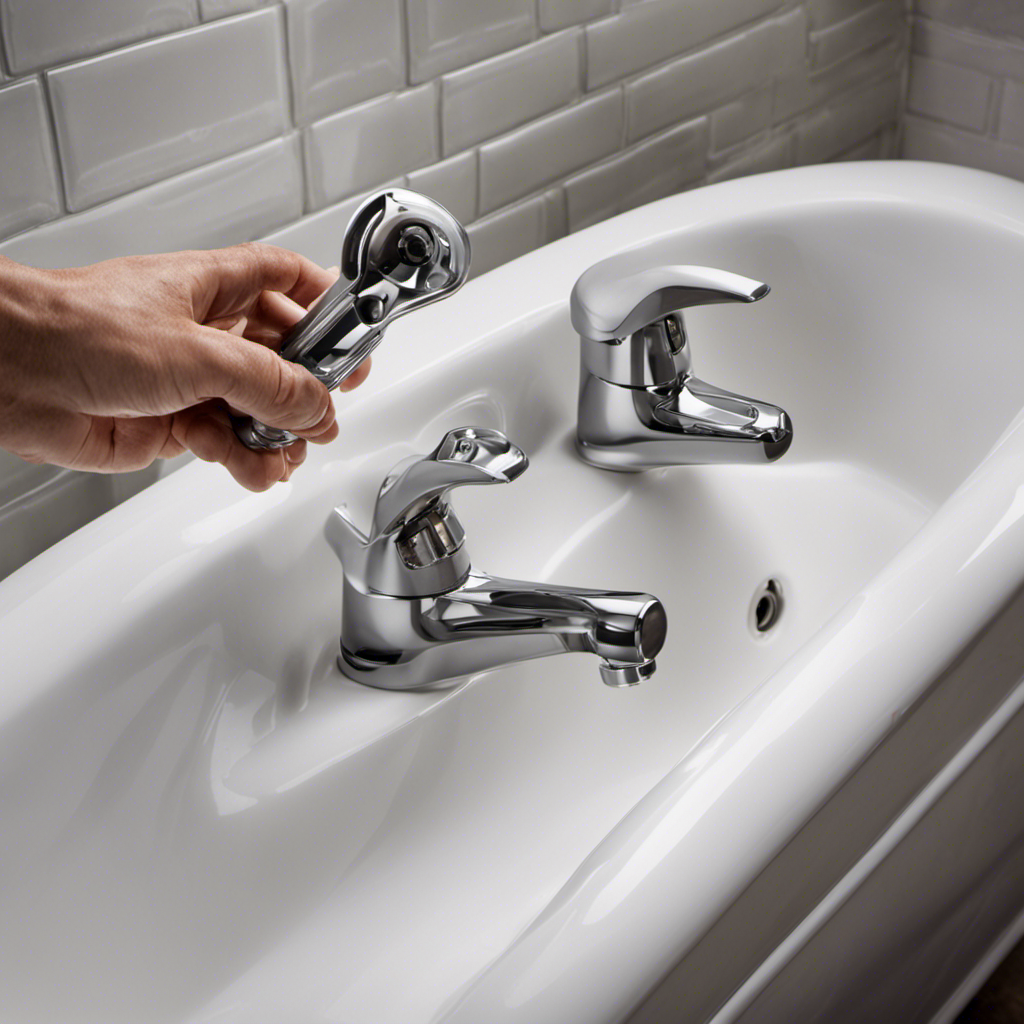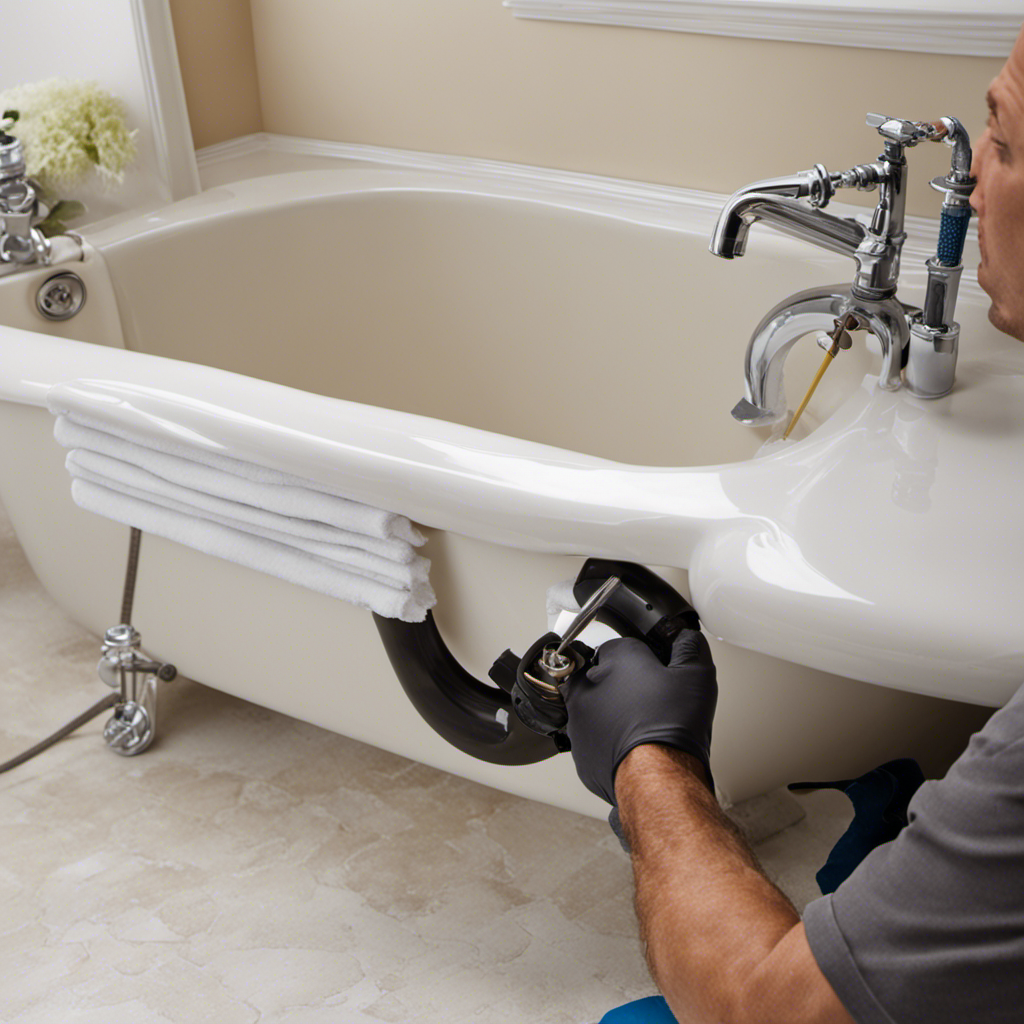Did you know that over 70% of homeowners experience chipped bathtubs at some point? If you’re one of them, don’t worry! This article will guide you through the process of repairing your bathtub chip.
You’ll learn how to assess the damage, gather the necessary materials, prepare the surface, fill the chip, and more. With these step-by-step instructions, you’ll be able to restore your bathtub to its former glory in no time.
So let’s get started!
Key Takeaways
- Assess the size, depth, and location of the chip to determine the appropriate repair method.
- Gather the necessary tools and materials, including a repair kit designed for porcelain or enamel surfaces.
- Prepare the surface by removing dirt and grime, and fill the chip with a fast-drying repair material.
- Ensure proper drying of the repair by increasing ventilation, using fans or a hairdryer on a low heat setting.
Assessing the Damage
You’ll need to carefully examine the chip in your bathtub to determine the extent of the damage. Start by inspecting the size and depth of the chip. Is it a small surface blemish or a deep crack that extends into the structure?
Next, evaluate the location of the chip. Is it in a visible area or hidden behind a shower curtain? Consider the impact on the overall aesthetics of your bathroom.
After assessing the damage, you can begin evaluating your options. If the chip is minor and doesn’t affect the functionality or appearance of the tub, you might consider DIY repair kits. However, for larger or more significant chips, it’s advisable to seek professional repair services. They have the expertise and tools to ensure a long-lasting and seamless repair.
Gathering the Necessary Materials
To get started, gather all the materials you need for the repair. Choosing the right repair kit is crucial for a successful bathtub chip repair. Look for a repair kit specifically designed for porcelain or enamel surfaces. These kits usually include a filler material, an adhesive, and a finishing compound.
Additionally, you will need a few tools such as a putty knife, sandpaper, and a sponge. Proper application techniques are essential to ensure a seamless repair. Follow the instructions provided with the repair kit carefully.
Begin by cleaning the damaged area with a mild cleaner and drying it thoroughly. Then, apply the filler material using a putty knife, making sure to level it with the surrounding surface. Once the filler has dried, sand it down to achieve a smooth finish.
Preparing the Surface
Start by thoroughly cleaning the damaged area with a mild cleaner to ensure a smooth and seamless repair. Surface preparation is crucial for a successful bathtub chip repair. Here are three key steps to follow:
-
Remove any dirt or grime: Use a soft cloth and a mild cleaner to gently scrub the damaged area. Make sure to remove any soap scum, oils, or residue that may be present. This will help the repair material adhere properly.
-
Sand the surface: Use a fine-grit sandpaper to lightly sand the chipped area. This will create a rough surface for the repair material to bond with, improving its durability and longevity.
-
Clean and dry the area: After sanding, wipe away any dust or debris with a clean cloth. Then, ensure the surface is completely dry before starting the repair process. Moisture can interfere with the adhesion and curing of the repair material.
Filling the Chip
Once the surface is clean and dry, it’s time to fill in the damaged area with the repair material. To ensure a seamless and durable repair, choose a fast-drying repair material that is specifically designed for bathtub chips. These materials are typically epoxy-based and offer excellent adhesion and water resistance. Additionally, they come in a variety of color options to match your bathtub’s original finish.
To guide you in selecting the right color, refer to the manufacturer’s color chart or consult a professional. Once you have chosen the appropriate color, carefully mix the repair material according to the instructions provided. Apply the mixture to the chip using a putty knife or a similar tool, making sure to fill the damaged area completely. Smooth out the surface with the putty knife, removing any excess material.
Allow the repair to dry completely before sanding and polishing to achieve a smooth, finished look.
Smoothing the Surface
Use a sanding block to smooth out any rough edges on the surface. This step is crucial in achieving a seamless repair.
Here are three reasons why using a sanding block is essential:
-
Precision: A sanding block allows you to have better control and accuracy while smoothing the surface. Its rigid structure ensures consistent pressure, resulting in a uniform finish.
-
Matching Techniques: By using a sanding block, you can create a smooth surface that perfectly blends with the surrounding bathtub material. This is especially important when repairing colored or patterned surfaces.
-
Faster Drying: Sanding the repaired area helps to remove any excess filler material and roughness, allowing for faster drying. This will speed up the overall repair process, saving you valuable time.
After sanding, it is important to move on to the next step, allowing the repair to dry completely. This will ensure the longevity and effectiveness of your bathtub chip repair.
Allowing the Repair to Dry
When repairing a bathtub chip, it is crucial to allow the repair to dry properly before using the bathtub. The drying time for the repair can vary depending on factors such as the type of repair material used and the temperature and humidity levels in the room.
Proper drying is important because it ensures that the repair is fully hardened and durable, preventing any future damage. To facilitate faster drying, you can use techniques such as using a fan or heater to increase air circulation and warmth in the room, or using a hairdryer on a low heat setting to gently dry the repair.
Drying Time for Repair
After applying the filler, it’s important to let it dry completely before proceeding with any further steps. Proper drying ensures a successful and long-lasting repair.
Here are three tips for quick drying and common drying mistakes to avoid:
- Use a fan or open windows to increase air circulation and promote faster drying.
- Avoid applying excessive filler, as it will take longer to dry and may crack or shrink.
- Don’t rush the drying process by using heat sources like hairdryers or heaters, as they can cause the filler to bubble or warp.
By following these tips, you can ensure that your bathtub chip repair dries efficiently and effectively.
Now that the repair is dry, let’s move on to the next section to understand the importance of proper drying in achieving a seamless finish.
Importance of Proper Drying
Now that you’ve learned about the drying time for repairing a bathtub chip, let’s discuss the importance of proper ventilation in preventing further damage.
Proper ventilation is crucial during the drying process to ensure the repair material sets correctly and to prevent the growth of mold or mildew. When the repair material is exposed to fresh air, it can dry evenly and adhere properly to the surface. Inadequate ventilation can lead to prolonged drying times and even failure of the repair.
To ensure proper ventilation, open windows and doors in the bathroom and use fans to circulate air. This will help to remove excess moisture and allow the repair to dry thoroughly.
Tips for Faster Drying
To speed up drying, make sure you place a fan near the repaired area and keep it on for several hours. This will help evaporate the moisture and ensure a faster drying process. Here are some additional techniques you can use to expedite the drying of your bathtub chip repair:
-
Use a hairdryer: Set the hairdryer to a low heat setting and direct the airflow towards the repaired area. Move the hairdryer back and forth to evenly distribute the heat and dry the surface quickly.
-
Apply heat: If possible, use a heat gun or a heat lamp to provide targeted heat to the repaired area. Be cautious not to overheat or damage the surrounding materials.
-
Increase ventilation: Open windows and doors to improve air circulation and promote faster evaporation. You can also use a dehumidifier to reduce humidity levels, which will aid in drying the repaired chip.
Sanding the Repair
Gently sand the repaired area using fine-grit sandpaper to smooth out any rough edges. This step is crucial in the refinishing process of your bathtub chip repair.
By sanding the area, you will create a smooth surface that will seamlessly blend with the rest of the bathtub. Start by lightly sanding the edges of the repaired area, applying even pressure to avoid creating any additional damage. Make sure to remove any loose particles or debris before proceeding.
Next, use a polishing technique to further refine the sanded surface. This can be done by using a polishing compound and a soft cloth, applying gentle circular motions. The polishing technique will help restore the shine and luster to the repaired area, making it virtually indistinguishable from the rest of the bathtub.
Applying Primer
Before applying primer, make sure to clean the sanded area thoroughly to ensure proper adhesion. Primer application is a crucial step in repairing a bathtub chip, as it provides a strong base for the subsequent layers of paint or epoxy. Follow these primer application techniques to achieve a professional-looking finish:
-
Choose the right primer: Select a primer that is specifically designed for use on bathtubs or other water-exposed surfaces. Look for a primer that is waterproof and has excellent adhesion properties.
-
Prepare the primer: Thoroughly mix the primer according to the manufacturer’s instructions. This ensures that the primer is evenly mixed and ready for application.
-
Apply the primer: Use a brush or roller to apply the primer to the sanded area. Apply a thin, even coat and make sure to cover the entire repaired area. Allow the primer to dry completely before applying paint or epoxy.
Painting the Repair
When it comes to painting the repair on your bathtub chip, there are two key points to consider: the drying and sanding process, and color matching techniques.
First, you will need to allow the primer to dry completely before moving on to the next step. This will ensure a smooth and even surface for the paint application.
Then, using the appropriate sandpaper grit, gently sand the primed area to create a surface that will hold the paint.
As for color matching, it is important to carefully select a paint color that matches the existing bathtub finish to achieve a seamless repair.
Drying and Sanding Process
To start the drying and sanding process, you’ll want to grab a clean towel and thoroughly dry the area around the chipped bathtub. This step is crucial to ensure proper adhesion of the repair material.
Once the area is dry, follow these sanding techniques and use the right sandpaper:
-
Begin by using a rough-grit sandpaper, such as 80 or 120 grit, to gently sand the chipped area. This will help create a smooth surface for the repair material to adhere to.
-
Next, switch to a finer grit sandpaper, such as 220 or 320 grit, to further smooth out the sanded area. Be careful not to press too hard, as this can damage the surrounding bathtub surface.
-
Finally, use a wet/dry sandpaper with a grit of 400 or higher to achieve a polished finish. Wet the sandpaper and lightly sand the area in a circular motion.
Once the sanding process is complete, you can move on to the next step of color matching techniques to seamlessly blend the repaired area with the rest of the bathtub.
Color Matching Techniques
You can achieve a seamless blend by carefully matching the color of the repair material with the surrounding area. When it comes to color matching techniques for bathtub chip repair, there are a few options you can consider. One method is to use color-matching kits that are specifically designed for this purpose. These kits usually come with a variety of pigments that can be mixed to match the color of your bathtub. Another option is to take a sample of the chipped material to a professional who can create a custom color match for you. This ensures a precise color match that seamlessly blends with your bathtub. If you’re unsure about your color matching skills, it’s always a good idea to seek professional help to ensure a flawless repair.
Table: Color Matching Techniques
| Method | Pros | Cons |
|---|---|---|
| Color-matching kits | Easy to use | Limited color options |
| Professional custom match | Precise color match | Costly |
| DIY color mixing | Cost-effective | Requires skill and practice |
Now that you know the color matching techniques, let’s move on to the next step: sealing the repair.
Sealing the Repair
Once the bathtub chip repair is complete, it’s important to seal the area properly to prevent further damage. Here are three key steps you should follow to ensure a successful seal:
-
Clean the area: Before applying the sealant, make sure the repaired chip is clean and free of any dust, debris, or moisture. Use a mild detergent and a soft cloth to gently clean the area, then dry it thoroughly.
-
Choose the right sealant: Select a high-quality bathtub sealant that is specifically designed for chip repairs. Look for one that offers fast drying techniques to minimize the time required for the sealant to set.
-
Apply the sealant: Using a small brush or applicator, carefully apply the sealant to the repaired chip, ensuring that it covers the entire area. Follow the manufacturer’s instructions for drying time and curing process.
Maintaining the Repaired Chip
After sealing the repaired area, it’s essential to regularly clean and maintain it to ensure its longevity.
To maintain the repaired chip, start by using a non-abrasive cleaner and a soft cloth to wipe down the surface. Avoid using harsh chemicals or abrasive scrubbers, as these can cause further damage.
It’s also important to prevent future damage by being cautious with sharp objects that could chip or scratch the surface. Consider using a mat or non-slip adhesive strips in the bathtub to reduce the risk of accidents.
Additionally, avoid filling the tub with hot water, as extreme temperatures can weaken the repaired area.
Frequently Asked Questions
How Long Does It Take for the Repair to Dry Completely?
It’s important to let the repair dry completely before using your bathtub. The best drying methods vary depending on the type of repair, but common mistakes include rushing the drying process.
Can I Use Any Type of Paint to Cover the Repaired Chip?
You can’t use any type of paint to cover the repaired chip. Use an epoxy enamel paint specifically designed for bathtub repair. Alternatively, you can consider using a bathtub repair kit or hiring a professional for a seamless finish.
Is It Necessary to Sand the Repair Before Applying Primer?
Before applying primer, it is necessary to sand the repair for proper adhesion. Sanding alternatives may not provide the same level of surface preparation. Choose a high-quality primer specifically designed for bathtub repairs.
Can I Use a Hairdryer to Speed up the Drying Process?
Using a hairdryer to speed up the drying process of a bathtub chip repair can be effective. However, it may cause uneven drying and potential damage. Consider using a heat gun for faster, more controlled drying.
How Often Should I Reseal the Repaired Chip to Maintain Its Longevity?
To maintain the longevity of the repaired chip, you should reseal it regularly. The frequency of resealing depends on factors such as usage and cleaning. Use high-quality products specifically designed for resealing bathtubs.
Conclusion
In conclusion, by following these precise steps, you can repair that unsightly chip in your bathtub.
Assess the damage, gather the necessary materials, and prepare the surface.
Fill the chip, smooth the surface, apply primer, and paint the repair.
Finally, seal the repair and maintain it for long-lasting results.
Don’t let a small chip ruin the overall look of your bathtub.
Take action now and restore its pristine condition, leaving you with a sense of accomplishment and satisfaction.










